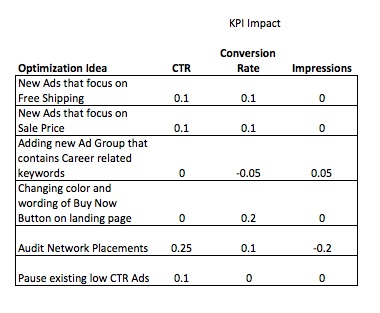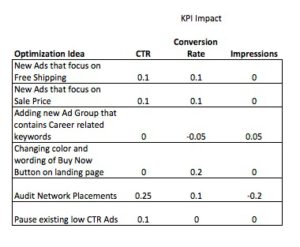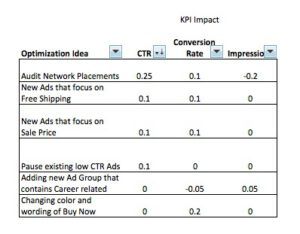3 Fail-proof Steps to PPC Optimization

Often we are in such a hurry to start optimizing that we dive straight into our accounts, start pulling levers, and leave the office with a wide grin knowing that we did something today we can learn from tomorrow (or next week depending on the account’s size.)
Unfortunately that does work sometimes. I say unfortunately because this is a case of winning the battle but forgetting that we are at war. This mad-method of chasing after results has provided just enough positive feedback for us that we haven’t had our backs sufficiently pressed against the proverbial wall. There’s been just enough daylight between us and the point of no way but forward that it hasn’t been worth depriving ourselves of our PPC Comfort Zone. So we keep spinning our wheels instead of drastically altering our approach to optimization.
Deep in our hearts, well usually right at the forefront of our brains, we know there is a more structured way for determining what to test/optimize and when we’ve found something that really makes the needle move. So without further ado, here are my three steps for more structure PPC optimizations:
1. Figure out where to optimize
2. Determine what tests to run
3. Identify when to end the tests
Pretty easy and self-evident, right? It mostly is, but let’s dig in further.
1. Where to Optimize
Determining what to test is based on determining what metric you want to impact (CTR, conversion rates, impressions) and then figuring out what is currently negatively impacting those metrics. For example, is your CTR low in campaigns that have no negative keywords, or is conversion rate great for career related keywords but you only have a few in your account so you aren’t maximizing impressions.
Why is this step important? Aren’t we always painfully aware of what is not working in an account? Maybe. Think about how often you know you need to drive down CPL so you pause keywords and ad groups. But what does this do? It reduces spend, not necessarily CPL. Or have there ever been times when you’ve needed to increase spend, but your first step was to reduce bids because you were also over CPL goal? The point I am trying to make is that even if we know what metrics are off, we don’t always take the time to really think through where our focus should be.
Determining what is affecting your account(s) can be as easy as looking at your overall average CPC and comparing it to where you need to be, and it can be as difficult as digging into site-flow in Analytics and determining on what pages you are losing site visitors, where they are going, and what seems to be deterring them from continuing on the conversion path. A good place to start is by simply comparing where you KPI’s are currently in relation to the past.
2. What Test(s) to Run
As we PPC managers like to do, I have broken this step down to an even more granular level!
2a The first part of this step is to brainstorm. Your desired end result is to find as many ideas for optimization as possible. You should be uninhibited at this stage, involve others and keep going far past the point where you thought, “”I can’t possibly think of one more way to optimize this account, landing page, ad, etc.” Your list should be expansive, and include the ridiculous and the mundane.
2b After you have made this monster list of possibilities determine which are the high impact/low resource items. This is going to take some time, but usually you’ll end up with a much smaller, 2-3 item task list that is packed with only actions that are sure to make the needle move. To determine this assign a suspected percentage of impact to KPI for each item. This is just your best guess, hopefully based on a lot of experience, for what the greatest impact a successful test would make on your metrics.
If you have multiple KPI’s that your tests could affect—for example CTR, conversion rate, impressions— then your list may look a little complicated. Here’s a screenshot of my list:
You can see that I’ve even assigned negative impacts based on what I would suspect would happen if I ran the indicated test. For example, if I Audit Network Placements and exclude several that send a lot of impressions my way but with few clicks, I would expect my CTR to increase and my impressions to decrease drastically.
From here you can create a filter and sort your ideas by the biggest impact to your desired KPI. So let’s say that I really want to increase my CTR. I would sort my CTR in column in descending order and….
Now I can see that my best bet is to do that Audit of my network placements. Of course, this was pretty obvious on my short list. But ideally you would have dozens, if not hundreds of ideas that you would be sorting through.
Bonus Round: If you want to take this to the next level, you can add another column for estimated time it will take you to complete the task. That way you can weigh both the potential impact and the time it will require when determining which tests to run.
Doing a spreadsheet like this also allows you to circle back around at the end of your test and determine if the impact was more or less than you anticipated. You can then adjusted your predictions in the future.
3. When is the End
More importantly, when do you worry about the end? The answer is, at the beginning. It’s a little deceiving that this is step 3 because it is directly tied to step 1. When you start down the path of optimization, you need to know what you want to impact (step 1) and what you want the impact to be (step 3).
Understanding not just what you expect the outcome to be, but what outcome equals success is an important missing step in many tests. So before you pres play on any test make sure you’ve laid out goals that measure not just complete success but moderate success as well. Here’s what end goals for my test to increase CTR looks like:
You can see that I now can benchmark my end results against what isn’t acceptable, what’s great. Plus there is some wiggle room for good, but not as great as I wanted. What this allows me to do is determine if the marginal returns are still worth pursuing, or if I need to cut bait entirely and pursue something that might make a larger impact.
Lastly, make sure you reach statistical significance for your tests. We’ve written about this many times, so I won’t bore you with the details but you can read more here. The important thing is just to make sure your results are meaningful before you take action on them.
For some tests the results can be the next day (if you are trying to increase spend, do start some tests, and spend doesn’t increase over the next 24 hours, it’s probably not going to work out for you.) But sometimes the results are going to take weeks. The important thing here is that just like you are going to start doing for goals, decide on how long to run the test first, before you ever begin.






